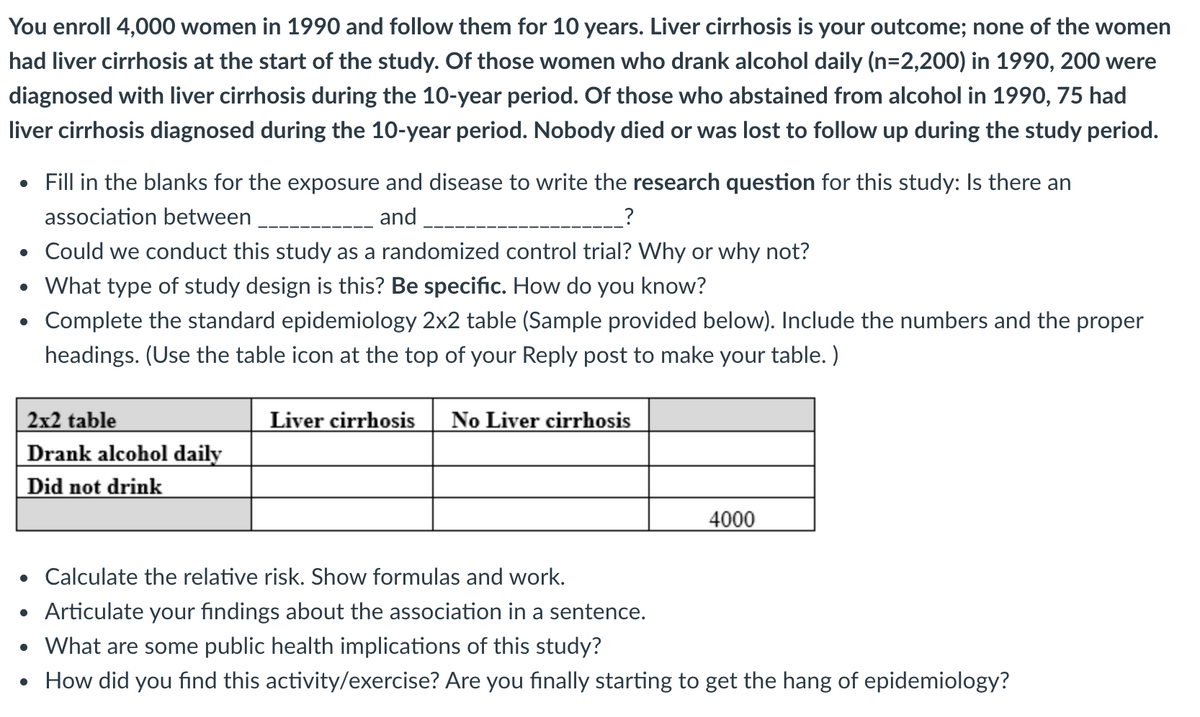You enroll 4,000 women in 1990 and follow them for 10 years. Liver cirrhosis is your outcome; none of the wom had liver cirrhosis at the start of the study. Of those women who drank alcohol daily (n=2,200) in 1990, 200 wer diagnosed with liver cirrhosis during the 10-year period. Of those who abstained from alcohol in 1990, 75 had liver cirrhosis diagnosed during the 10-year period. Nobody died or was lost to follow up during the study perioc • Fill in the blanks for the exposure and disease to write the research question for this study: Is there an association between and • Could we conduct this study as a randomized control trial? Why or why not? • What type of study design is this? Be specific. How do you know? Complete the standard epidemiology 2x2 table (Sample provided below). Include the numbers and the proper headings. (Use the table icon at the top of your Reply post to make your table. ) 2x2 table Liver cirrhosis No Liver cirrhosis Drank alcohol daily Did not drink 4000 • Calculate the relative risk. Show formulas and work. Articulate your findings about the association in a sentence. • What are some public health implications of this study? • How did you find this activity/exercise? Are you finally starting to get the hang of epidemiology?
You enroll 4,000 women in 1990 and follow them for 10 years. Liver cirrhosis is your outcome; none of the wom had liver cirrhosis at the start of the study. Of those women who drank alcohol daily (n=2,200) in 1990, 200 wer diagnosed with liver cirrhosis during the 10-year period. Of those who abstained from alcohol in 1990, 75 had liver cirrhosis diagnosed during the 10-year period. Nobody died or was lost to follow up during the study perioc • Fill in the blanks for the exposure and disease to write the research question for this study: Is there an association between and • Could we conduct this study as a randomized control trial? Why or why not? • What type of study design is this? Be specific. How do you know? Complete the standard epidemiology 2x2 table (Sample provided below). Include the numbers and the proper headings. (Use the table icon at the top of your Reply post to make your table. ) 2x2 table Liver cirrhosis No Liver cirrhosis Drank alcohol daily Did not drink 4000 • Calculate the relative risk. Show formulas and work. Articulate your findings about the association in a sentence. • What are some public health implications of this study? • How did you find this activity/exercise? Are you finally starting to get the hang of epidemiology?
Linear Algebra: A Modern Introduction
4th Edition
ISBN:9781285463247
Author:David Poole
Publisher:David Poole
Chapter2: Systems Of Linear Equations
Section2.4: Applications
Problem 28EQ
Related questions
Question
I need help answering this discussion post. The topic is Identifying study design and making contingency tables.

Transcribed Image Text:You enroll 4,000 women in 1990 and follow them for 10 years. Liver cirrhosis is your outcome; none of the women
had liver cirrhosis at the start of the study. Of those women who drank alcohol daily (n=2,200) in 1990, 200 were
diagnosed with liver cirrhosis during the 10-year period. Of those who abstained from alcohol in 1990, 75 had
liver cirrhosis diagnosed during the 10-year period. Nobody died or was lost to follow up during the study period.
• Fill in the blanks for the exposure and disease to write the research question for this study: Is there an
association between
and
• Could we conduct this study as a randomized control trial? Why or why not?
• What type of study design is this? Be specific. How do you know?
Complete the standard epidemiology 2x2 table (Sample provided below). Include the numbers and the proper
headings. (Use the table icon at the top of your Reply post to make your table. )
2x2 table
Drank alcohol daily
Did not drink
Liver cirrhosis
No Liver cirrhosis
4000
• Calculate the relative risk. Show formulas and work.
• Articulate your findings about the association in a sentence.
• What are some public health implications of this study?
• How did you find this activity/exercise? Are you finally starting to get the hang of epidemiology?
Expert Solution
This question has been solved!
Explore an expertly crafted, step-by-step solution for a thorough understanding of key concepts.
This is a popular solution!
Trending now
This is a popular solution!
Step by step
Solved in 2 steps with 1 images

Recommended textbooks for you

Linear Algebra: A Modern Introduction
Algebra
ISBN:
9781285463247
Author:
David Poole
Publisher:
Cengage Learning

Holt Mcdougal Larson Pre-algebra: Student Edition…
Algebra
ISBN:
9780547587776
Author:
HOLT MCDOUGAL
Publisher:
HOLT MCDOUGAL

Linear Algebra: A Modern Introduction
Algebra
ISBN:
9781285463247
Author:
David Poole
Publisher:
Cengage Learning

Holt Mcdougal Larson Pre-algebra: Student Edition…
Algebra
ISBN:
9780547587776
Author:
HOLT MCDOUGAL
Publisher:
HOLT MCDOUGAL